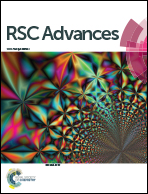Phosphonate-modified metal oxides for the highly selective enrichment of phosphopeptides†
Abstract
Metal oxide affinity chromatography has become one of the most widely used strategies for phosphopeptide enrichment prior to mass spectrometry analysis, but some defects still exist in this approach due to the complex physical and chemical properties of the metal oxide surface. Although the simultaneous phosphorylation of adjacent amino acids may greatly affect the bioactivity of the protein, there are few reports on the specific enrichment of multi-phosphopeptides. In this work, we report a highly selective enrichment method for capturing phosphopeptides or multi-phosphopeptides based on phosphonate-modified metal oxides. Compounds with different numbers of phosphate groups were adsorbed on the surface of ZrO2 and TiO2 to obtain phosphonate-modified metal oxides. Among them, phosphoric acid modified metal oxides (1P-ZrO2 and 1P-TiO2) could significantly enhance their selectivity towards phosphopeptides; and alendronate-modified metal oxides (2P-ZrO2 and 2P-TiO2) showed high selectivity for the enrichment of multi-phosphopeptides. In addition, the detection sensitivity was greatly improved by using these novel materials. The mechanism of the specific enrichment was considered to be ligand exchange and blocking of strong adsorption sites by the compounds containing the phosphate group. Finally, tryptic digests of proteins of human Jurkat-T cell lysate were further used to demonstrate the selectivity and specificity of ZrO2, 1P-ZrO2 and 2P-ZrO2.


 Please wait while we load your content...
Please wait while we load your content...